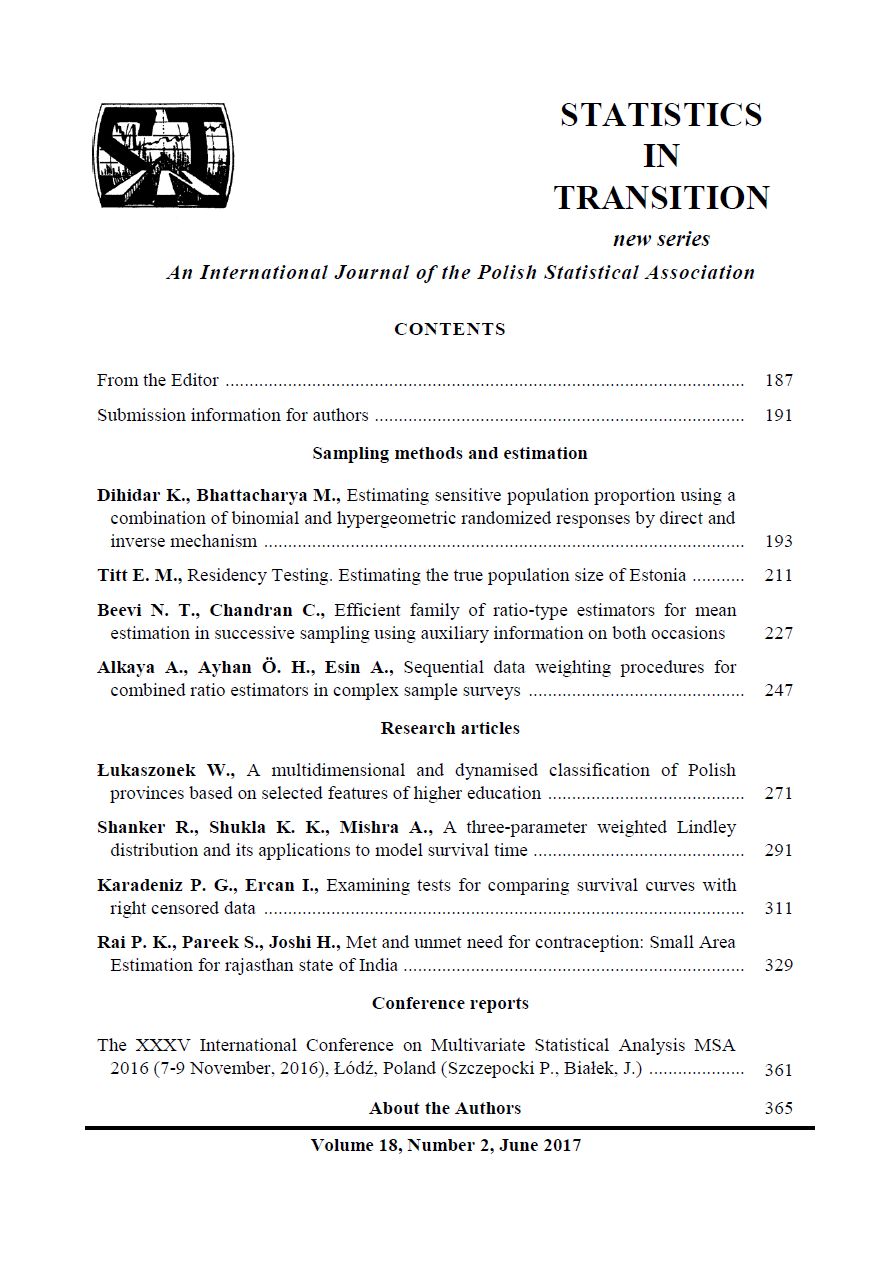ARTICLE
ABSTRACT
For close to two decades after the fall of communism in 1989, Polish higher education enjoyed an unprecedented period of development. Favourable political, economic, social and demographic changes led to a fivefold increase in the number of students and the number of higher educational institutions. The dynamic changes and their effects did not occur uniformly, in either space or time. An attempt is made here to identify and analyse the regional differentiation between Polish provinces in terms of features relating to higher education. To investigate the changes in higher education in the period of economic and social transformation, observations were made of fundamental characteristics of higher education in the years 2002–2013. The applied procedure uses new statistical methods applicable to a space of doubly multivariate data. The covariance matrix used to construct principal components is given the structure of a Kronecker product. The results led to the identification of six groups of provinces, including two consisting of a single province – Mazowieckie and Małopolskie provinces – which contain the largest and the highest-ranked higher educational institutions in Poland: the University of Warsaw and Jagiellonian University.
KEYWORDS
higher education, doubly multivariate data, cluster analysis, dendrite method, covariance matrix, Kronecker product
REFERENCES
ANTONOWICZ, D., (2012). External influences and local responses. Changes in Polish higher education 1990–2005, in: KWIEK M., MAASSEN P., (eds.), National Education Reforms in a European Context. Comparative Reflections on Poland and Norway. Frankfurt: Peter Lang, pp. 87–111.
DERĘGOWSKI, K., KRZYŚKO, M., (2009). Principal components analysis in case of multivariate repeated measures data. Biometrical Letters, 46 (2), pp. 163–172.
FLOREK, K., ŁUKASZEWICZ, J., PERKAL, J., STEINHAUS, H., ZUBRZYCKI, S., (1951). Taksonomia wrocławska. Przegląd Antropologiczny, 17, pp. 193–211.
GAŁECKI, A. T., (1994). General class of covariance structures for two or more repeated factors in longitudinal data analysis. Communications in Statistics –Theory and Methods, 23, pp. 3105–3119.
GIRI, N.C., (1996). Multivariate Statistical Analysis. New York: Marcel Dekker, Inc.
GOLINOWSKA, S., ed. (2005). Raport Społeczny Polska 2005. Fundacja im. Friedricha Eberta.
GUS, (2010, 2012, 2015). Rocznik Statystyki Międzynarodowej. Główny Urząd Statystyczny.
HOTELLING, H., (1933). Analysis of a complex of statistical variables into principal components. Journal of Educational Psychology, 24 (6), pp. 417–441.
KRUSKAL, J. B., (1956). On the shortest spanning subtree of a graph and the traveling salesman problem. Proceedings of American Mathematical Society, 7, pp. 48–50.
KRZYŚKO, M., SKORZYBUT, M., (2009). Discriminant analysis of multivariate repeated measures data with a Kronecker product structured covariance matrices. Statistical Papers, 50, pp. 817–835.
KRZYŚKO, M., SKORZYBUT, M., WOŁYŃSKI, W., (2011), Classifiers for doubly multivariate data. Discussiones Mathematicae. Probability and Statistics, 31, pp. 5–27.
KWIEK, M., (2009). The two decades of privatization in Polish higher education. Cost-sharing, equity, and access. Sense Publishers.
KWIEK, M., (2014). Structural changes in the Polish higher education system (1990–2010): A synthetic view. European Journal of Higher Education, 4 (3), pp. 266–280.
MACH, B., (2003). Pokolenie historycznej nadziei i codziennego ryzyka:Społeczne losy osiemnastolatków z roku 1989. Wydawnictwo Instytutu Studiów Politycznych PAN.
MISZTAL, B., ed. (2000). Prywatyzacja szkolnictwa wyższego w Polsce: wyzwania w świetle transformacji systemowej. Kraków: Universitas.
NAIK, D. N., RAO, S., (2001). Analysis of multivariate repeated measures data with a Kronecker product structured covariance matrix. J. App. Statist. 28, pp. 91–105.
PRIM, R. C., (1957). Shortest connection networks and some generalizations. Bell System Technical Journal, 36, pp. 1389–1401.
ROY, A., KHATTREE R., (2005). On implementation of a test for Kronecker product covariance structure for multivariate repeated measures data. Statistical Methodology, 2, pp. 297–306.
SIKORSKA, J., (1998). Konsumpcja: Warunki, zróżnicowania, strategie. Wydawnictwo Instytutu Filozofii i Socjologii PAN.
SRIVASTAVA, M. S., von ROSEN, T., von ROSEN, D., (2008). Models with a Kronecker product covariance structure: estimation and testing. Mathematical Methods of Statistics, 17 (4), pp. 357–370.
TROW, M., (1973). Problems in the transition from elite to mass higher education. Carnegie Commission on Higher Education, Berkeley.
WALESIAK, M., (2014). Przegląd formuł normalizacji wartości zmiennych oraz ich własności w statystycznej analizie wielowymiarowej. Przegląd Statystyczny, 61 (4), pp. 363–372.
WASIELEWSKI, K., (2013). Caught in the trap of mass education –transformations in the Polish higher education after 1989, in: SZAFRANIEC K. and KONSTANTINOVSKIY D. (eds.). Polish and Russian Youth: Education and Work in Changing Society. IS RAS, Moskwa.
WNUK-LIPIŃSKA, E., (1996). Innowacyjność a konserwatyzm: uczelnie polskie w procesie przemian społecznych. Wydawnictwo Instytutu Studiów Politycznych PAN.
ZIÓŁKOWSKI, M., (2000). Przemiany interesów i wartości społeczeństwa polskiego. Teorie, tendencje, interpretacje. Wydawnictwo Fundacji Humaniora, Poznań
